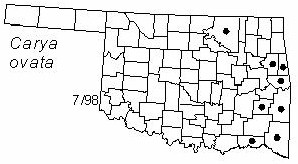Tree to 20 m (65 ft) tall and 50 cm (18 in) diameter, with shaggy bark and narrow rounded crown. Bark light gray and rough, becoming separated into long narrow loosely attached strips on older trunks and branches. Twigs thick, gray or brown, hairy when young. The single terminal bud is large, egg-shaped, with numerous brown hairy overlapping scales. Leaves alternate, pinnately compound, 20-35 cm (8-14 in) long. Leaflets usually 5, elliptical or ovate, 7.5-18 cm (3-7 in) long, acuminate, finely serrate, glabrous yellow-green above, pale green and usually hairy below. Teeth of leaflets ending in a tuft of short hairs Flowers catkins appearing in the early spring. Fruits rounded, 3-6 cm (1.2-2.4 in) long, with a thick husk.
Distribution: Native to about the eastern 1/2 of the U. S. and isolated locations in the mountains of Mexico.
Habitat: well-drained floodplain forests and mesic upland forests.
NWI status: FACU+
Comment: The nuts of all the hickories are important food for wildlife, especially squirrels. The seeds of shagbark hickory are edible. Carya is the ancient Greek name for walnut; ovata refers to the ovate leaflets.
Distribution in Oklahoma: 
BACK
NEXT
RETURN TO INDEX
Last update: 9/8/99
 Go to Oklahoma Biological Survey Home Page
Go to Oklahoma Biological Survey Home Page
 Disclaimer
Disclaimer